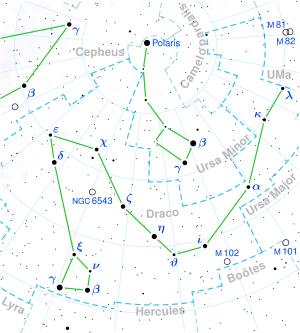| Observation data Epoch J2000 Equinox J2000 | |
|---|---|
| Constellation | Draco |
| Right ascension | 17h 36m 25.89931s[1] |
| Declination | +68° 20′ 20.9096″[1] |
| Apparent magnitude (V) | 9.15[2] |
| Characteristics | |
| Spectral type | M3.5 V[3] |
| U−B color index | 1.06 |
| B−V color index | 1.49 |
| Astrometry | |
| Radial velocity (Rv) | −28.90±0.13[1] km/s |
| Proper motion (μ) | RA: –320.675 mas/yr[1] Dec.: –1269.893 mas/yr[1] |
| Parallax (π) | 219.7898 ± 0.0210 mas[1] |
| Distance | 14.839 ± 0.001 ly (4.5498 ± 0.0004 pc) |
| Absolute magnitude (MV) | 10.87 |
| Details | |
| Mass | 0.40±0.02[4] M☉ |
| Radius | 0.4183±0.0070[5] R☉ |
| Luminosity | 0.02128±0.00023[5] L☉ |
| Surface gravity (log g) | 4.66[6] cgs |
| Temperature | 3,413±28[5] K |
| Metallicity [Fe/H] | +0.11 ± 0.20[6] dex |
| Rotation | 61.8±1.0 d[7] |
| Rotational velocity (v sin i) | <2.8[8] km/s |
| Other designations | |
| Database references | |
| SIMBAD | data |
Location of Gliese 687 in the constellation Draco | |
Gliese 687, or GJ 687 (Gliese–Jahreiß 687) is a red dwarf in the constellation Draco. This is one of the closest stars to the Sun and lies at a distance of 14.84 light-years (4.55 parsecs). Even though it is close by, it has an apparent magnitude of about 9, so it can only be seen through a moderately sized telescope. Gliese 687 has a high proper motion, advancing 1.304 arcseconds per year across the sky. It has a net relative velocity of about 39 km/s.[2] It is known to have a Neptune-mass planet.[7] Old books and articles refer to it as Argelander Oeltzen 17415.[9]
- ^ a b c d e Cite error: The named reference
GaiaDR3was invoked but never defined (see the help page). - ^ a b c Cite error: The named reference
SIMBADwas invoked but never defined (see the help page). - ^ Cite error: The named reference
apj649_1_436was invoked but never defined (see the help page). - ^ Cite error: The named reference
Feng2020was invoked but never defined (see the help page). - ^ a b c Cite error: The named reference
Boyajianvon Braun2012was invoked but never defined (see the help page). - ^ a b Cite error: The named reference
apj644was invoked but never defined (see the help page). - ^ a b Cite error: The named reference
687b-discoverywas invoked but never defined (see the help page). - ^ Cite error: The named reference
apj704_2_975was invoked but never defined (see the help page). - ^ Cite error: The named reference
Oeltzen17415was invoked but never defined (see the help page).

